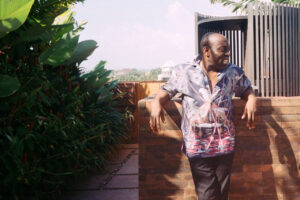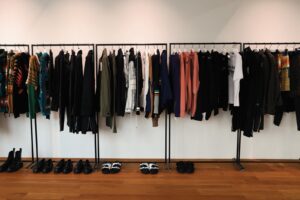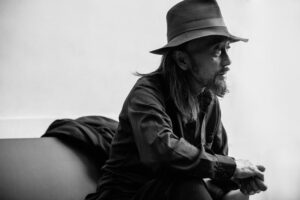This story was originally published in issue #38 of 032c Magazine and was written and produced by FM Belowground project director Arthur Bray. Check out the full story here.
Words: Arthur Bray
Photography: Leo Sharp
It’s difficult to speak of London’s skate scene without mention of Southbank’s Undercroft. Planted firmly on the side of the River Thames since the 1970s, the concrete slabs shadowed by the London arts center have been the breeding ground to some of the city’s most revered skaters. Despite not being an official skate park, its unique location by the waterfront has opened a dialogue between tourists and passersby with the city’s creatives, bridging the gap between social circles that have little in common. Legendary skateboarder Mark Gonzales notes, “Southbank is a place that holds historic value. A place where skaters can mingle with the average person without feeling intimidated and watched like animals.”
Ten years ago, the Southbank Undercroft also birthed a brotherhood of skaters known as PWBC – Palace Wayward Boys Choir – named after Victorian religious charities of past British aristocracy. Many of these skaters lived in a shabby South London skate house dubbed the ‘Waterloo Palace’ and would frequent Southbank to sell products to local skaters and film VHS tapes. A few would go on to ride for Palace Skateboards, the tongue-in-cheek imprint helmed by Lev Tanju that blurred the lines between skate and fashion. Thinking back, Girl Skateboards’ Andrew Brophy who frequented the undercroft during the emergence of PWBC said, “We were just homies whipping it on the fun planks all day and then whipping it at the bars all night, the gang was so sick! The PWBC fam went hard, no doubt at all, there were no fucks given what so ever.”
After threats in 2013 of redevelopment from the Southbank Center, which intended to bulldoze the iconic skate spot to turn it into retail units, the undercroft is still standing. Palace Skateboards has become ubiquitous in the street fashion landscape, joining the ranks of Supreme in its coveted goods and worn by its celebrity skate team, Drake, and Kanye’s daughter North West.
From the late 1990s to the mid 2000s, British photographer Leo Sharp shot skaters like Ollie Todd, Lucien Clarke, Andrew Brophy, Danny Brady, Chewy Cannon and Rory Milanes in their London habitat and on skate trips to Russia and China. Some of these skaters later appeared across PWBC’s early lo-fi footage, while others scored their own signature Palace boards. Here, Sharp shares portraits of the young skateboarders before they joined Palace and explains the importance of the undercroft.
















Arthur Bray: How did you become acquainted with these skaters?
Leo Sharp: I’ve known them since they were a fair bit younger. I shot photos of all of them at one time or another for Sidewalk skateboarding magazine.
What was it like to photograph skateboarding in Russia and China?
It was really interesting to see how skateboarding was developing in different countries, and to see how the general public viewed the activity in places where people barely knew what it was. Chinese citizens will stand in crowds and watch you skate for hours.
Here, you’ve focused on Toddy, Lucien, Rory, and Brady. What did you want to capture in these photos?
The same as anyone that I’ve ever shot. Technical skateboarding performed by someone having fun on their plank. Other than that, hopefully a bit of individuality, style and poise. Each of the names you’ve mentioned, they all have their own authenticity, are in complete control of their skateboards, and have vastly differing styles. I’d hope to capture the specific skate spot in the image – giving the viewer a feel for the location, wherever it is in the world.
What was Southbank like in the mid 2000s compared to today?
Southbank has always been a London staple skate spot. Just look at organisations like Long Live Southbank and the passion of the people behind them. It makes you realize what that place means to British skateboarding. I grew up in Milton Keynes, but would regularly get the train to London to skate Southbank and the Shell center in the late 80s and early to mid 90s. Southbank then was kind of a sketchy place with all the homeless people living there, but it was raised to be able to skate the small banks and bank to wall as well as the big banked area with the seven which is really all that’s left. I hope the money can be raised to open up the rest of the undercroft to skate again.
Why do you think Southbank is such a holy grail to skaters?
It’s the home of British skateboarding. Simple as that. It’s appeared in more skate magazines and videos than anywhere else and I believe is one of the first places that documented that skateboarding actually took place in the UK. The ground is perfectly smooth and was even good for early clay skateboard wheels. The “maverick” architects that designed the Queen Elizabeth Hall actually tried to create a shared space for people to interpret as they wanted. It’s hard to believe that the banks weren’t actually made for skateboarding. The decades of different people, sessions, events, and tours that that place has seen, not to mention local skaters hanging out pretty much constantly around the clock give Southbank a really historic feeling. When you’re there, you can feel it in your bones … Along with the dirt on your skin and the black bogies up your nose!
Can you tell us a bit about the portrait series? Lucien looks really young there, how old was he?
The Brophy and Lucien portraits were shot on a DVS Shoes trip to Mallorca. I think that was around 2008. Not sure how old Lucien would have been then? But it was definitely pre-Palace era Lucien. I remember him falling asleep with a plate of potato wedges and barbecue sauce on his lap, then finding him the next morning covered in gnarly ants after the sticky sauce!
Lucien Clark
Andrew Brophy
What about the shot of Gibbsy at Southbank?
I think this was shot on a Circa Shoes trip. Chris Gibbons was the UK rider, but I think the US team were over shooting an article for Sidewalk. The area around Southbank had been freshly refurbished, including this new wall or rail configuration. I shot it from up on the first level. It wouldn’t have taken many tries – Gibbsy is a Welsh legend!
Gibbsy Crooks in Southbank
Can you tell us a bit about the photo of Lucien skating in Old Street?
We were trying to shoot at this spot in rush hour. We kept having to wait for gaps in the people to try the trick, but the flow of humans was almost constant. There have been many frequently skated spots in London other than Southbank. Elephant & Castle ledges, ‘Jazz square’ (Gillett square) in Dalston, Chalky ledges at St. Paul’s Cathedral, to name a few.
Lucien Clark on Old Street
Where was the portrait of Brady and Chewy taken?
The Chewy and Brady portraits are from a Blueprint skateboards trip to Mallorca in 2003. It was the last filming trip for the Blueprint video ‘Lost and Found’. Blueprint used to do a trip to Mallorca every year during January and February when it was really hard to film in the frozen UK. They would always rent a big house on the north coast of the island near Pollensa or Alcudia. This was way before anything like AirBnB, but you could still get good deals online. The places would have 10 bedrooms and a pool, and out of season would cost very little. A couple of rented cars later and the mild weather and skateable architecture on the island was, and still is, a skateboarder’s paradise.
Danny Brady
Chewy Cannon
What’s your favorite photo from the selection?
Probably Brophy’s switch ollie over the wall in St. Petersburg. He just happened to be making the same gesture as the statue of Stalin in the background. We did a lot of travelling on that trip – most notably the train journey from Moscow to St. Petersburg. It was an eye opener seeing the gap between rich and poor in Russia.
Andrew Brophy in Russia







